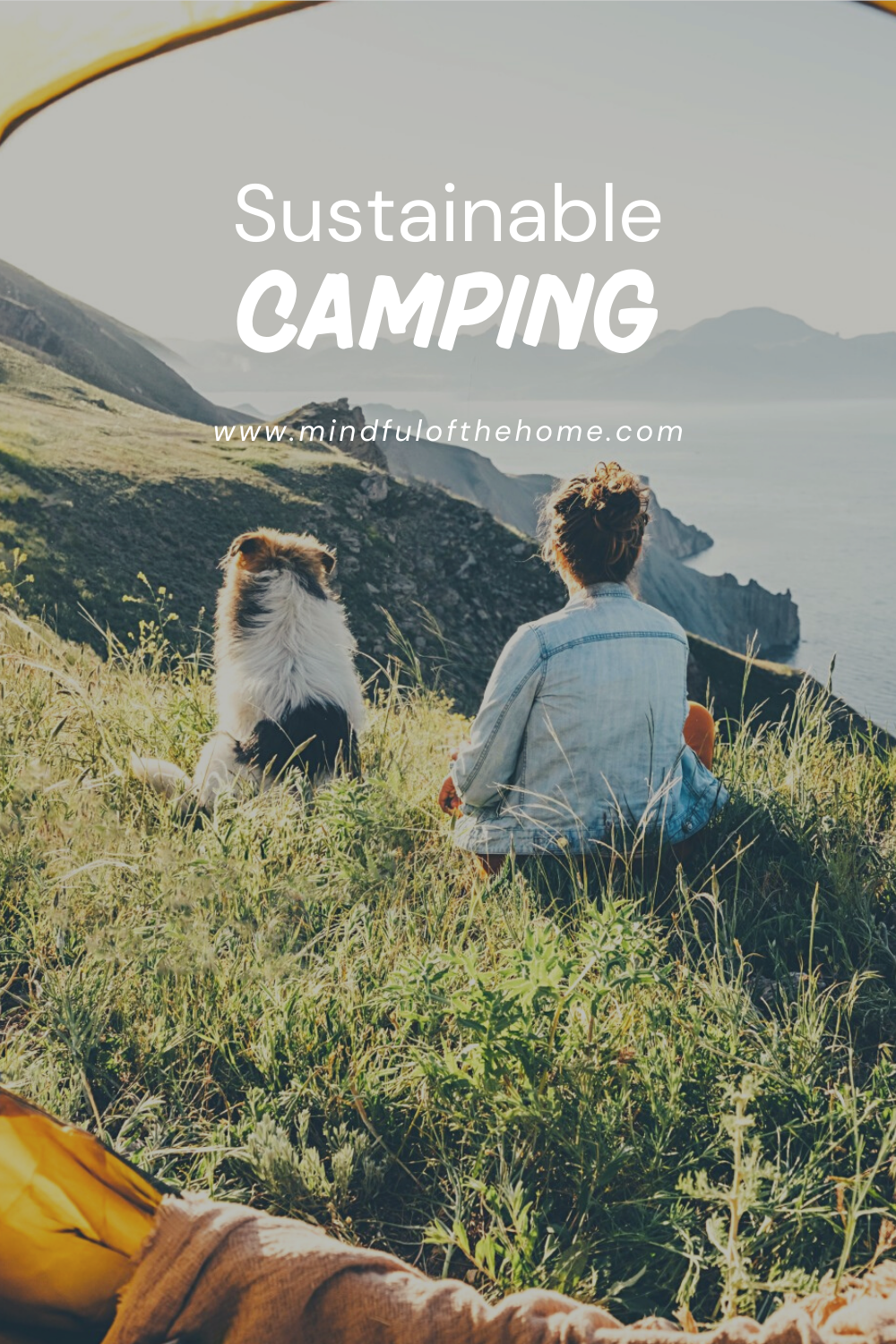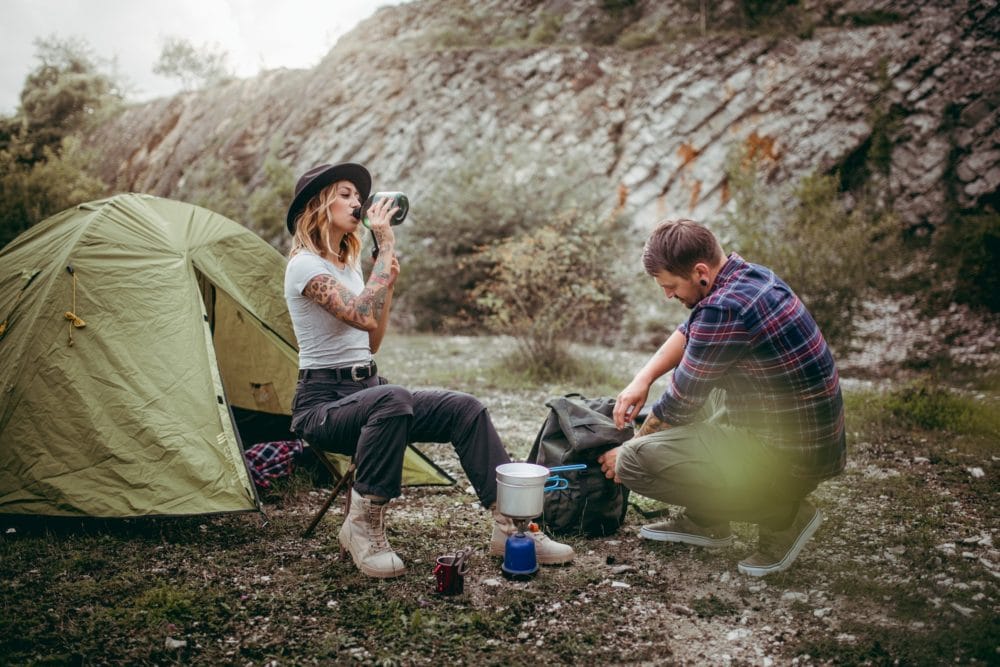For some people, camping in a natural landscape beats a hotel room any day. But what should you do when you also want to be mindful of the environment while you’re camping?
Whether you’re camping in a national park or in a local campground, these eco camping tips will help you reduce waste and camp with the environment in mind.
What is eco camping?
Eco camping, sustainable camping, or zero-waste camping all revolve around camping with minimal impact on the environment. There are sustainable habits you can adopt, green products to use as well as zero-waste essentials to bring on your trip.
So if you’re looking to camp in the great outdoors to get some fresh air, improve your mental health, or simply for an experience, these easy camping tips will help you be more eco-friendly.

Here are the best tips to help you be more sustainable when camping without hurting your camping experience.
1. Use sustainable camping dinnerware
A great place to start when eco camping is to skip the disposables. Bring cups, plates, and bowls that can be washed at or near your campsite and reused.
Stainless steel plates, bowls, etc. are the best option for eco camping because they’re indestructible.
Wash your dishes immediately after eating before the food has a chance to harden to make washing almost effortless. All you need is a wet rag with a little dish soap and a quick rinse of water.
If you really want to stick with disposable, use paper plates, but ensure you take your garbage with you when you leave.
2. Use zero-waste cutlery

Don’t forget your cutlery! The best zero-waste option for utensils while camping is ones you can simply wash and stainless steel is usually the way to go.
You can often find sets that stack neatly onto each other for easy storage at local stores that sell camping supplies, but of course, you can also use utensils from home.
For reusable utensils that are a little more lightweight, there are bamboo cutlery options.
3. Use a reusable water bottle

There are already enough plastic water bottles littered across the world. Instead of disposable plastic water bottles when camping, use a large reusable water container with water from home and a stainless steel water bottle.
Having a large water container when camping will ensure that you have enough drinking water for your trip. You can also use that water to wash your dishes.
Invest in a high-quality reusable water bottle if you don’t have one already and refill it as needed.
4. Have a Water Filter

Depending on your needs and type of camping trip, you may need to choose a sustainable water filter.
Especially when backcountry camping, carrying around large amounts of water is not possible. Instead, water filters like LifeStraw allow you to drink directly from rivers and other water streams.
LifeStraw’s are cheap and small, making them a great item to have in your backpack in case of emergencies.
5. Clean with eco-friendly dish soap
If you’re going to be washing dishes at your camping site, be mindful of the cleaning products that you’re using.
Unless you’re bringing back the water that you washed your dishes with (which is unlikely), that water will need to be dumped nearby. However, many cleaning products aren’t environmentally-friendly and can harm the soil, water, and nearby animals.
Choose an eco-friendly dish soap that won’t harm the environment when dumped on the ground or harm water streams.
6. Reuse water bottles as ice packs
If you have plastic water bottles at home already, you might as well drink the water but hold onto the plastic bottles for future zero-waste camping.
Use those plastic bottles as ice packs over and over again! However, you shouldn’t drink the water you put in it, since disposable water bottles aren’t meant to be reused. This is because plastic toxins can leak into the water.
7. Freeze meals ahead of time
Another eco camping hack for keeping your food cold and fresh is to freeze your meals ahead of time, if possible.
This is a great solution because oftentimes people buy ice, which simply melts into the cooler and is usually just dumped out afterward. This way, your food stays cold and it helps conserve water.
8. Use zero-waste bathroom products
When camping, chances are you’ll be bringing along some bathroom supplies and every bathroom product has a zero-waste alternative.
Bringing along plastic-free bathroom products such as zero-waste toothpaste and bar soap is a good way to ensure you won’t leave any waste behind when eco camping.
Check out this huge list of zero-waste bathroom swaps for more ideas.
9. Rent camping gear

There are a few eco-friendly alternatives when it comes to camping gear. One of the best zero-waste things you can do is simply rent camping gear.
Unless you’re an avid camper, buying camping gear that may only be used once or twice a year may be redundant.
Additionally, if you want to skip the extra cost of renting gear, see if you have a friend who would be willing to lend you some of their camping supplies.
Camping gear your can rent or borrow:
- Tent
- Sleeping bag
- Mattress
- Backpack
- Cooler
- Cookware
- Camping chair
10. Buy second hand camping gear
Another sustainable option for camping equipment and other outdoor gear is to buy them secondhand.
Shopping secondhand will always be one of the best things you can do for the environment because it gives items a new life, and keeps the items out of landfills.
Discover why buying secondhand items is awesome.
11. Repair your camping gear
Do you have camping gear but something’s wrong with it? Do you actually need to buy something new? Repair is one of the R’s of zero-waste and for good reason.
Repairing items you already own is one of the best zero-waste things you can do because you’re keeping them out of the landfill and reducing the need to buy them again.
Before buying new to replace your broken gear, see if you can repair it yourself or hire someone to repair it for you.
12. Use plastic-free sunscreen and insect repellant

When camping, you’ll be exposed to the sunlight for extended periods of time and exposed to those pesky mosquitos. However, typically sunscreen and insect repellants are sold in plastic bottles.
For a more zero-waste option when camping, consider buying sunscreen that comes in a tin can and bug repellent that doesn’t come in a plastic container.
Choosing camping products that are made with more sustainable materials is a great way to be a more eco-conscious camper.
13. Use rechargeable batteries
Instead of using batteries that need to be thrown away when they no longer work, opt for rechargeable batteries.
Use these batteries in your headlamp, flashlights, etc. These rechargeable batteries can be charged via solar power.
14. Invest in a solar cooker
An awesome, although pricey way to reduce your carbon footprint when camping is to invest in a solar cooker such as Gosun which uses solar charges to cook food.
Being able to cook your own food via a solar panel is a great way to reduce resources since it means you don’t need to buy propane for an electric cooker.
15. Use a solar camping lantern
Another handy camping item to have on hand is a lantern and thankfully there are sustainable options as well.
You can get a solar-powered lantern that charges via the sun, which means you don’t need to worry about batteries.
16. Have responsible campfires
Fire safety is an important part of sustainable camping. Make sure fire doesn’t spread from your fire pit and of course, don’t burn garbage.
17. Leave no trace

Another important part of zero-waste camping is to leave no trace. Always leave your campsite spotless, which means picking up your supplies, garbage, toilet paper, etc. and cleaning up after your pets.
Leaving no trace helps keep the camping areas and mother nature as a whole clean and beautiful.
18. Pick the right location
When camping at campgrounds or in the wilderness, choose a spot unlikely to impact the environment.
For example, pitch your tent in a clearing or somewhere that has been previously camped on. The same goes for car camping. This helps keep these beautiful places and natural landscapes intact.
mother nature
19. Camp nearby and carpool
When choosing a location to camp at, try to find a campsite close to home. Less travelling means fewer carbon emissions, and if possible, try carpooling with friends and family.
20. Buy groceries near your campsite
Depending on where you’re going camping, you shouldn’t buy fresh food from the destination you’re leaving from. That’s just extra time you need to keep the food cool and risk it spoiling too soon.
If there’s a grocery store near your camping location, you may be better off purchasing groceries from that location.
21. Repurpose plastic containers for storage
If you’re going camping and need some containers for storage, you can reuse and repurpose old plastic containers like yogurt or coffee containers.
Repurposing plastic containers is a good way to be more zero-waste without the risk of damaging your higher-quality glass containers and it’s less heavy.
22. Bring a compost bin
Just because you’re camping, doesn’t mean you can’t still compost! Especially if you’re going to be camping for a long time, bring a small bin to hold your food scraps. Repurposing coffee containers would be a great option for this to help lock in the smell from wildlife.
Final thoughts on Eco Camping
Choosing to practice eco and zero-waste camping is a great way to help fight climate change. You’ll save money and help the environment at the same time.
Use these tips on your next camping trip!
Share these sustainable camping tips or save them for future reference!




